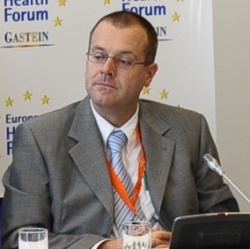Communicable disease programmes in Europe
One of the main topics at Health Forum Gastein 2009 was the way in which various healthcare systems struggle to cope with communicable diseases and their prevention. During the event, Dr Hans Kluge, Head of the Country Policies and Systems Unit, at the WHO regional office for Europe, spoke with Meike Lerner about omnipresent factors that work against effective TB and HIV/AIDS prevention programmes and suggested what needs to be done to ensure their strength and continuation.

Although the content of communicable disease prevention programmes, e.g. for TB control and HIV/AIDS, are quite well known, the shortcomings of healthcare and social systems as well as financial issues all present challenges to their implementation. ‘Basically, what we need for communicable disease interventions to be effective and sustainable is to be able to provoke changes in healthcare systems,’ said Dr Kluge. ‘I have worked for eight years on communicable diseases in the former Soviet Union and also on implementing the first programme in Siberian prisons in 1994, and was then active in central Asia, the Caucasus, Siberia, Russia, for example, on TB control. So, I can give you some examples.
‘There are four functions in a healthcare system that we must consider if we want to elevate it to communicable disease programmes. The first is about stewardship or governance. For example, and this is the most important, the political commitment has to change. If, for example, you are aiming for TB control in prisons, you will see that there are three vertical systems: the Ministry of Justice, which oversees the prison system and has its own infrastructure and resources; the Health Ministry, which has an old structure, and then between those is the Interior Ministry that runs detention centres where people are detained for a couple of days before their trials. Then, when prisoners are released they enter civilian society, which is under the Health Ministry. So already you have two that operate in one of the sectors and if you don’t have any interconnection from above, coordination is almost impossible.
‘Speaking about stewardship and governance means a commitment to what we call the social profile of TB patients. We are dealing with alcoholics, prisoners or ex-prisoners, people who are unemployed and really a very vulnerable part of society. So, if there is no recognition and profound understanding from the establishment of the social profile, you can have a good treatment regimen but will not really arrive at exterminating the disease.
‘Let’s move on to the second healthcare system function – financing. In east European regions, for TB and HIV control you have a fragmented healthcare financing system that sets up a TB service, HIV service, a prison service, but does not really look at targeting the patients. So we need to look at the financial mechanisms and make them more efficient. One concrete example we worked on was in the vulnerable oblast in the Russian Federation, the area has a system that encourages a long duration in hospital for TB patients. The longer they stay the more money the hospital receives. So, there is no incentive for the hospital manager to discharge TB patients early. This presents a whole set of problems; they are infected by other people, it is overcrowded, and so on. So, when we tried to reform the healthcare financing system we could use some of the savings for what we call incentives and enablers. For example, an incentive for TB patients is to give a social package containing soap, toothpaste or food, which encourages them to visit a TB dispensary. Or, the money could be used to pay the bus fares for a primary healthcare worker to visit a patient’s home and directly observe the treatment and ensure the patient takes the medication.
‘The third healthcare system function -- resource generation -- deals with human resources. One very important aspect is that it is difficult to attract young doctors, partly because of the low salary and then because they are afraid of the infection hazards. Personally, we know many young doctors who contracted the drug-resistant form of TB. So, you can implement a perfect healthcare programme but if you don’t consider the increasing issue of new resources it’s understandable that you are never going to attract young doctors, especially to deal with TB patients.
‘The last issue deals with service delivery. Again, looking at the vertical systems, there is a lot of political investment and interest in retaining the structure. But if you deal with drug-resistant TB, for example, the patient has to receive treatment for two years. Obviously it is not feasible for a specialist TB service to keep TB patients under treatment for two years. What you should do is involve primary healthcare, the nurses and so on, at the first point of entry. But again, for this you need necessary legislations. So, this was the first thing we talked about -- looking at a healthcare system if you want to tackle communicable diseases.
‘Then there's the financial crisis. This could be seen as an opportunity to do things that should have been done a long time ago, basically, getting away from inefficiencies and entrenched bureaucracies and systems, such as the fragmentation of healthcare services. It is like pumping money in four different vertical systems. We need to take a real look at the healthcare financing system and make it output-based. That does not mean pumping in money to make each programme happy, but pumping in money to ensure that you have successfully treated patients, because that’s the most important thing – not funding the system, but treating the patients.
‘This should be applicable to TB as well as HIV. Who is an HIV positive patient? Often, number one, an IDU, intravenous drug user (IDU), number two a prisoner or ex-prisoner. These people are either treated in an HIV department, or a surgery or a sexually transmitted infection department -- so many departments, which makes it really very costly and inefficient.
There is also concern that the crisis will badly impact on HIV prevention goals. Obviously, there is pressure from many groups not to cut back on the treatment programme, and rightly so, because AIDS patients need treatment. However, it could potentially be at the cost of prevention programmes. Despite the crisis, the level of funding for prevention should remain the same because, if we don’t prevent it now, HIV/AIDS control will become far more expensive in the decades to come, as seen in a number of Baltic States.
26.01.2010





